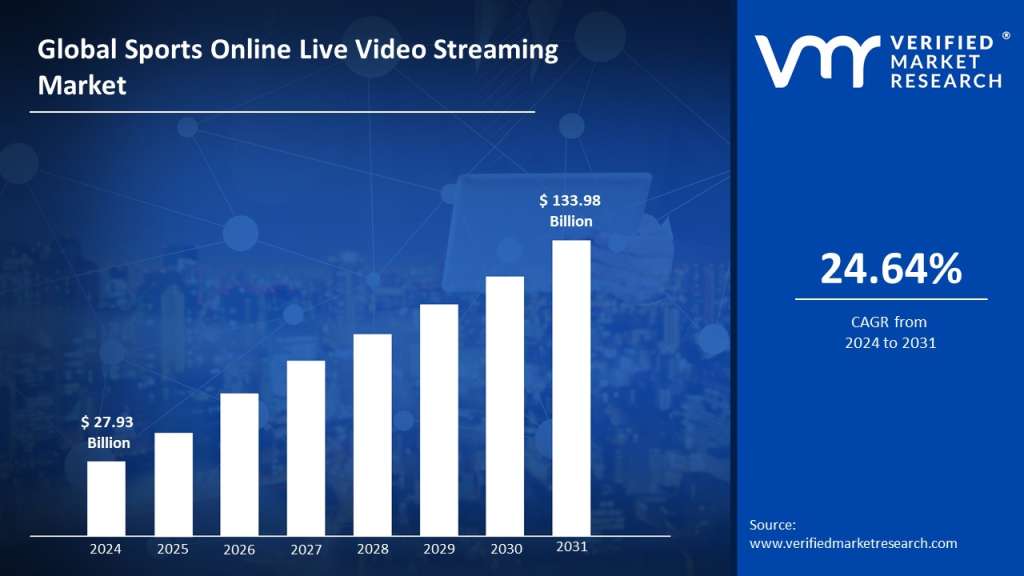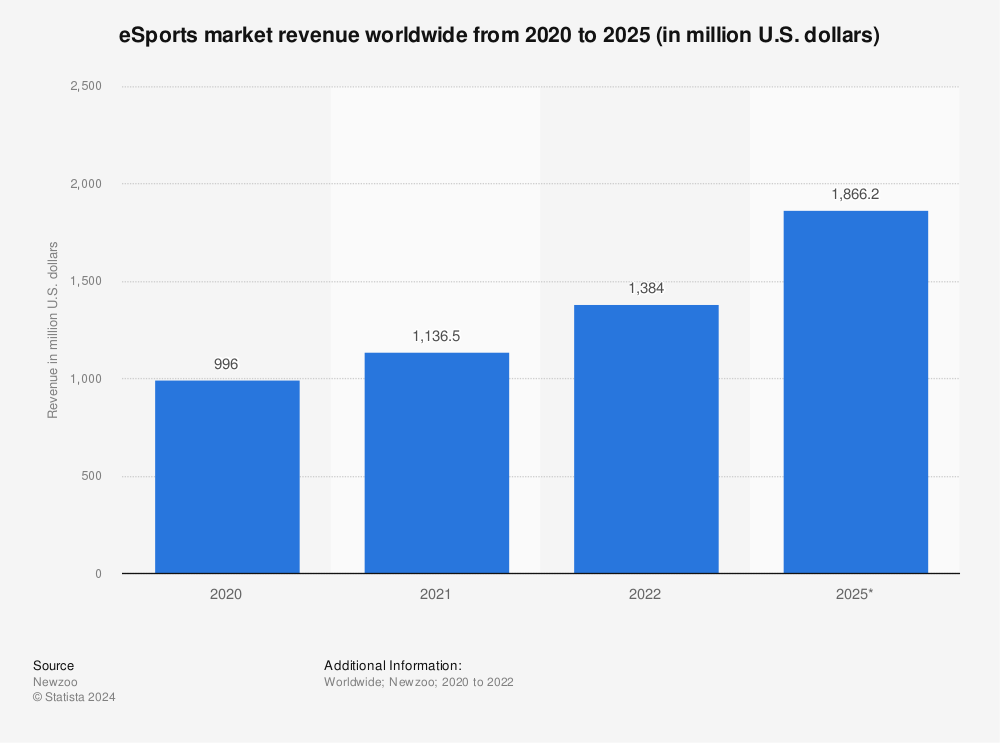In recent years, live-streaming sports events have become a mainstream trend, revolutionizing how fans consume sports content. This shift is not just driven by technology but also by the changing preferences of sports enthusiasts. Let’s dive into why live-streaming sports are gaining such widespread popularity.
Live Streaming Sports Gaining Popularity: Numbers Don’t Lie!
The growing popularity of live-streaming sports is not just a perception but a reality backed by impressive figures and statistics. As digital media takes over traditional broadcast models, here are key statistics that prove the rapid rise of live streaming in the sports industry.
Global Sports Streaming Market Growth
The global sports streaming market has experienced exponential growth over the past few years. In 2024, the sports online video streaming market was valued at approximately $27.93 Billion, and it is expected to reach $133.98 Billion by 2031, growing at a CAGR (Compound Annual Growth Rate) of 24.64% between the forecasted period.

Source: (Verified Market Research)
This surge is driven by rising internet penetration, increasing smartphone adoption, and growing demand for sports content across multiple devices.
Rise in Streaming Platforms and User Engagement
Major platforms like DAZN, ESPN+, Amazon Prime Video, and social media channels like YouTube and Facebook have witnessed significant user engagement in sports streaming. For instance, DAZN became Europe’s biggest digital sports broadcaster app and reported having 15 million subscribers worldwide in 2023. Amazon Prime Video recorded over 25 million viewers for its exclusive NFL “Thursday Night Football” streams in 2022.
Twitch, originally focused on gaming, is expanding its reach in sports live streaming, attracting millions of fans. In 2021, Twitch partnered with sports leagues like the NBA and NFL, attracting millions of sports viewers through interactive, community-driven streams.
Increased Mobile Streaming
One of the biggest drivers of live-streaming sports is the availability of mobile apps and smart devices. Statista reports that 80% of global sports fans now prefer to watch live sports on their smartphones. This shift highlights the growing demand for on-the-go access, with platforms like ESPN+ and YouTube TV capitalizing on the mobile-first audience.
In 2022, 42% of sports fans aged 18-34 stated that they primarily watch sports via streaming platforms rather than traditional TV, showcasing younger audiences’ shifting demographics and consumption preferences.
Live Streaming Engagement and Interaction
According to a study by MediaKix, live-streaming sports events increase viewer engagement by 27% compared to pre-recorded or traditional broadcasts. The ability to interact with fellow fans through live chats and social media platforms adds to the excitement of watching the event in real-time.
Social media platforms have also become integral to live sports engagement. For instance, the 2022 FIFA World Cup saw 1.1 billion people watching the final match, with over 93 million users engaging via social media platforms during the game. Many of these fans were either live-streaming the match or interacting in real-time through social media channels.
eSports as a Growing Segment of Live Sports
While traditional sports dominate live streaming, eSports is a booming industry contributing significantly to the live streaming trend. The global eSports audience grew to 532 million in 2023, with projections to reach 646 million by 2026. Additionally, the eSports industry’s market revenue is estimated to reach 1.87 billion dollars in 2025.

Source: (Statista)
Streaming platforms like Twitch and YouTube Gaming have been the driving force behind eSports, offering live coverage of tournaments, player streams, and interactive fan experiences.
AR, VR, and 4K Technology Integration
As more streaming services integrate cutting-edge technologies like 4K streaming, AR, and VR, sports fans are enjoying immersive experiences. According to Statista, by 2027, there will be 65 million VR users who engage in sports-related content. This tech allows fans to watch games as if they are physically present in the stadium, enhancing the live experience significantly.
Impact of Social Media Integration on Sports Streaming
The integration of social media with live-streaming platforms has created a multiplier effect. According to Nielsen, 46% of sports fans are more likely to engage with live streams if the platform has social media integration. Facebook’s live streaming service, Facebook Watch, has seen success with its sports-related content, with over 720 million people watching sports content monthly.
OTT Platforms Dominating Live Sports
OTT (Over-The-Top) platforms are taking over traditional broadcasting networks when it comes to sports streaming. In 2022, over 1.5 billion people globally used OTT services to watch sports events, and this figure is expected to reach 3 billion by 2027, according to PwC. OTT services offer flexibility, allowing fans to stream events without relying on fixed schedules or cable TV contracts.
Why is Live Streaming Sports so Popular?
The media landscape is changing dramatically. Television has dominated media for almost years and is losing ground rapidly to streaming media services such as Amazon and Netflix. Likewise, top streaming media boxes include Apple TV, Chromecast, Roku, Amazon Fire TV, etc. It displaces traditional cable subscriptions in short cord-cutting in the TV content and video world as well. It has become more of the norm in today’s digital era.
Sports have been a big component of television, addressing almost 40% of all TV viewing. Nevertheless, professionals are noticing that the market is shifting. More sports organizations are streaming tournaments, games, competitions, and matches through the internet. Why? Both on-demand and live-streaming software offer some significant advantages associated with traditional television broadcasts. Let’s have a close look right here.
Lower Barriers to Entry
Having a slot on broadcast television is difficult and expensive as well. It simply means that the most prominent brands can offer access to the traditional TV broadcast approach. On the other hand, live sports streaming does not involve competing for limited space on the airwaves; hence prices are lower.
Global Audience
The widespread syndication itself presents different types of logistical challenges. It helps to reach a global audience with television broadcasts is completely difficult.
Multi-Device Streaming
Some people worldwide even don’t have a TV. That said, smartphones and tablets are leapfrogging ahead and are becoming a widespread chain. Live streaming through the internet provides the ability to tap into a vast audience wherever that is on their devices.
Smart Broadcasts
Apart from the discussed point above, live streaming sports provide unique possibilities, especially in broadcast live sports events. For instance, some sporting brands are broadcasting multiple camera angles for live games. It enables viewers to choose which vantage points they watch their favorite game from, giving them greater consumer control.
Generate Revenue
Ad-supported video on demand (AVOD), transactional video on demand (TVOD), or Pay-per-view (PPV) have always been popular models. Live streaming pay-per-view (PPV) sports enables you to integrate the standard practice easily.
Shift to Scalable Live Sports Streaming
More people these days are “Cutting-the-Cord” or performing cable subscriptions. They prefer it because it makes it easier for them to move to an internet-based entertainment approach. The process is in progress for now, but it, however, represents the near future. Young people, these days are much more likely to subscribe to satellite or cable and are more likely to use streaming media services.
Increasingly, most brands are catching on to live streaming as well. For example, Yahoo started streaming a free Major League Baseball game every day in 2016. However, Twitter has followed and has grabbed the National Football League’s contract to live-stream Thursday Night Football games.
Exciting Experience
High-speed 5G internet with HD and 4K resolution videos make live sports streaming a fantastic experience. It reduces the legal complexity and expense of negotiating contracts with multiple partners and distributors.
The live-streaming trend is clear; it is the future of entertainment and media. It involves the broadcasting of viewers’ favorite sports. The trend is still in its initial stage, but early adopters tend to reap numerous advantages. What are you waiting for? Charge yourself at full speed to enter the end zone and begin live-streaming sports right away!
How Do Sports OTT Platforms Make Money?
From live sports to streaming, OTT platforms simply make money through subscription models. The three most common monetization models are transactional video on demand (TVOD), subscription video on demand (SVOD), and ad-supported video on demand (AVOD).
AVOD helps you to make money through an advertisement that takes place during the content. However, with SVOD, subscribers need to pay annual or monthly charges for unlimited access to streaming content. In contrast, TVOD is equivalent to a pay-per-series model or pay-per-video model.
OTT Sports Streaming: It’s the New Beginning!
Live OTT sports streaming is growing dramatically. About 1.3 million homes dropped traditional satellite TV services and traditional services in the second quarter of 2020. OTT platforms have gained massive popularity in the last few years.
Large broadcasters are not the only ones who are profiting from live streaming. Niche sports channels are seeing success from a defined audience with specific interests. Live streaming enables you to personalize the content delivery and viewing experience as well.
Improving the ROI of live-streamed content is essential and will ensure that your live-streaming efforts are worth the time and effort you invest in capturing it. The OTT sports streaming landscape is growing. Adding live sports to the streaming and content repertoire will get the OTT channel in the game.
Frequently Asked Questions
What is live streaming sports?
Live streaming sports involves broadcasting real-time sporting events over the internet using streaming platforms. It allows viewers to watch matches, games, and tournaments as they happen, just like on traditional television.
Why are people using online streaming platforms for live sports?
People are turning to online streaming platforms for live sports due to several reasons:
- Convenience;
- Global Access;
- Flexibility;
- Interactivity;
- Cost-Efficiency.
How can businesses leverage live streaming for marketing?
Businesses can use live streaming for various marketing purposes:
- Product Launches
- Q&A Sessions
- Showcasing business operations and culture can humanize your brand.
- Sponsor sports events that align with your brand values for increased exposure.
- Partner with influencers, athletes, or other brands for joint live-streaming events.
How can I monetize live-streaming sports?
You can monetize live streaming through various means:
- Sponsorships and Partnerships: Collaborate with brands that want exposure during your streams.
- Advertisements: Integrate ads into your streams or offer ad-free premium subscriptions.
- Pay-Per-View: Charge viewers to access premium content or specific matches.
- Merchandising: Promote and sell branded merchandise during streams.
- Subscription Models: Offer exclusive content through subscription tiers.
Can small businesses benefit from live-streaming sports as well?
Absolutely. Live streaming levels the playing field, allowing small businesses to engage with a global audience and create personalized, interactive experiences without the need for significant budgets.
What should I consider when investing in a live-streaming platform?
Factors to consider include the platform’s user base, features (interactivity, monetization options), compatibility with your content and branding, and the quality of customer support.

